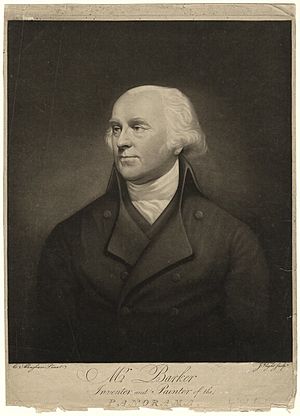Robert Barker (painter) facts for kids
Robert Barker (born 1739 – died 1806) was a famous painter from Kells, County Meath, Ireland. He is best known for inventing the "panorama," a special type of painting that made viewers feel like they were right in the middle of the scene.
Contents
Robert Barker: The Panorama Inventor
Robert Barker was a painter who traveled a lot. In 1792, he created the word "panorama." This word comes from two Greek words: pan (meaning "all") and horama (meaning "view"). He used it to describe his paintings of Edinburgh, Scotland. These paintings were shown on a round, cylinder-shaped surface. Soon, he was showing them in London as "The Panorama."
The First Panorama
The Barker Panorama of Edinburgh from Calton Hill is thought to be the very first panorama. It is now kept at the University of Edinburgh. This set of six pictures shows a full 360-degree view of Edinburgh. It looks like you are standing on Calton Hill.
A Special Building for Panoramas
In 1793, Barker moved his panoramas to the world's first building made just for them. This building was designed by Robert Mitchell and built in Leicester Square, London. Barker became very rich from this. People eagerly paid three shillings to stand on a platform in the middle of the room. A skylight above gave the paintings even light. This made people feel like they were truly inside the scene.
The word "panoramic" (meaning a wide view) first appeared in print in 1813. Soon after, in 1801, the word "panorama" also came to mean a "full look" at a topic. Visitors to Barker's London Panorama could buy prints of the painting. This panorama showed London as if seen from the roof of Albion Mills.
How Panoramas Worked
Barker's panoramas were very clever. They used special tricks with perspective. This was different from older wide-angle city views. When Barker first got a patent for his method in 1787, he called it La Nature à Coup d’ Oeil. This means "Nature at a glance" in French.
At that time, educated people were starting to appreciate "picturesque" views. When they traveled to beautiful places like the Lake District, they sometimes carried a "landscape glass." This was a large lens in a picture frame. Holding it at arm's length would make a wide view look like a small picture.
The Success of Panoramas
Barker's Panorama was a huge hit. It led to many other "immersive" (meaning you feel like you're inside) panoramas. The Museum of London found records of 126 panoramas shown between 1793 and 1863. In Europe, artists like Franz Roubaud created panoramas of historical events and battles. Most big European cities had special buildings for panoramas.
Later, in the late 1800s, these large, fixed panoramas became less popular. But in the United States, they had a small comeback. During this time, they were often called cycloramas.
Moving Panoramas and Beyond
In Britain and the US, the idea of a wide view grew even more. This led to the "Moving Panorama." This was a long canvas scroll that unrolled past the viewer. This idea was similar to old hand-held landscape scrolls from the Song dynasty in China.
Eventually, moving panoramas were replaced by "moving pictures," which we now call motion pictures. A similar invention was the diorama. This was a detailed scene in a room-sized box with special lighting. It was shown in Paris and came to London in 1823. The inventor, Louis Daguerre, had learned from a panorama painter.
Robert Barker passed away on April 8, 1806. He was buried in Lambeth, Surrey.
Family Life
One of Robert Barker's sons, Henry Aston Barker, was also an artist. He helped his father and then continued the family business of painting and showing panoramas. His oldest son, Thomas Edward Barker, was not an artist. But he also helped run the family's business. In 1801, Thomas started his own panorama show with artist Ramsay Richard Reinagle in The Strand, London.
See also
- Panorama
- Panoramic painting
- International Panorama Council



